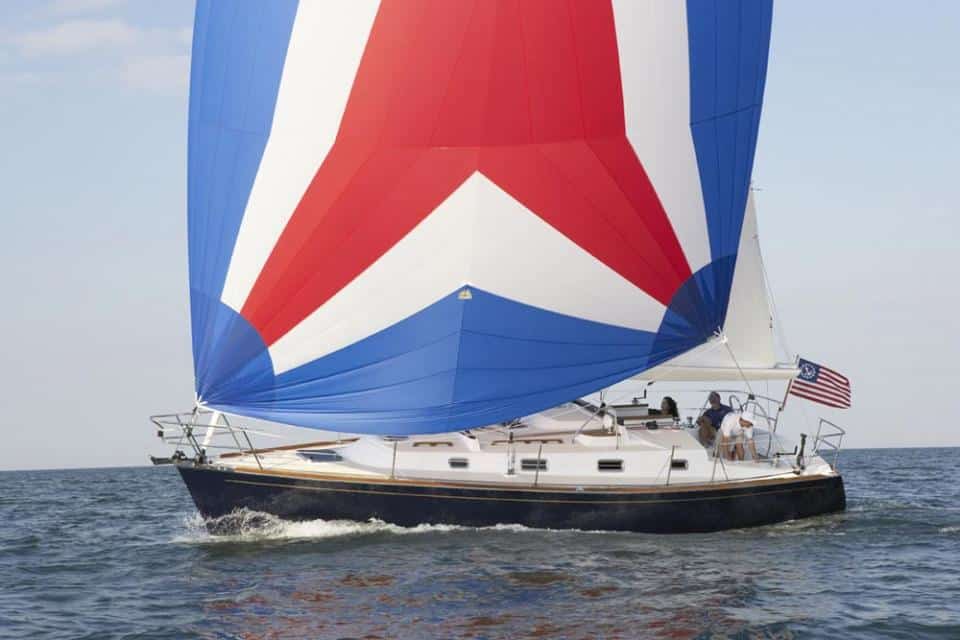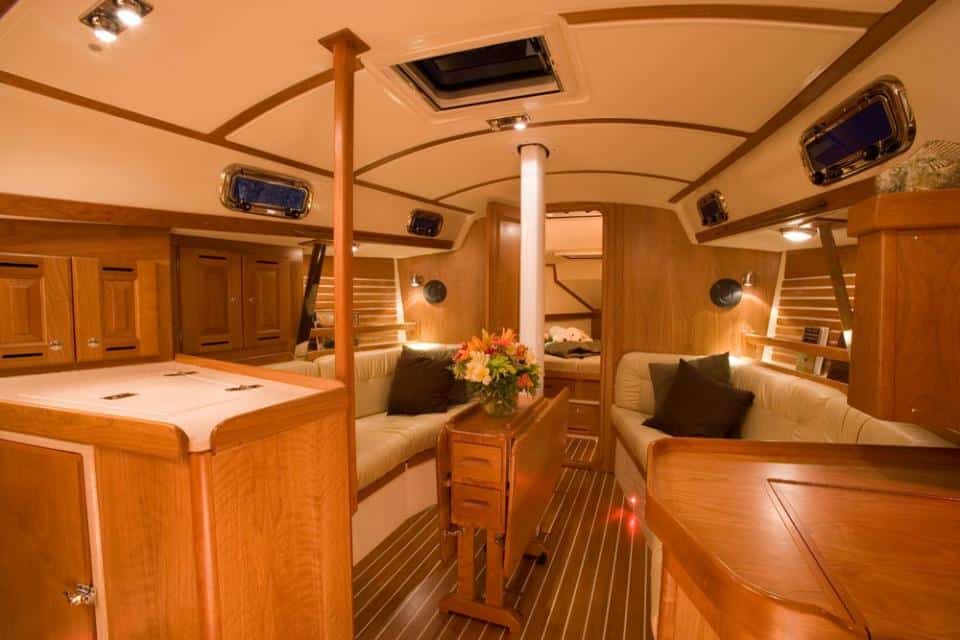
Until the late 1960s and early 1970s, a sailboat’s shape and dimensions were largely determined by the rating rule under which it was to be sailed, because most people who sailed also raced. It wasn’t until the late 1970s that cruising became popular enough in its own right that boatbuilders could afford to build boats expressly for that purpose. From that time on, a cruising sailboat’s dimensions and shape have been determined by how its manufacturer perceives its market.
Tartan Yachts has consistently aligned its products to suit the tastes and demands of the times. In the 1960s and 1970s, it built boats attuned to the prevailing racing scene. Today, the firm has identified its customers as wanting a boat for cruising, one able to carry a full load of creature comforts and yet be nimble enough to be fun to sail in club racing; it must also be distinctive in appearance. In the Tartan 3400, the company succeeded so well in blending these requirements that the boat won the 2006 Cruising World Boat of the Year award for Best Production Cruiser from 31 to 36 Feet.
Thirty years ago, the idea of putting a forward double cabin, an aft double cabin, an enclosed head with stall shower, a roomy saloon, a galley, and a stand-alone navigation station in a 34-foot hull would have been preposterous. Today, it’s expected.
You could put a 1967 Tartan 34 inside the new Tartan 3400 and-at the aft end anyway-walk around between the two hulls. What today’s boat loses in intimacy, it gains in amenities-without even gaining any weight-and with it, Tartan Yachts has definitely raised the accommodations ante. Designer Tim Jackett has accomplished this not with mirrors but with freeboard, beam, art, and a few corners craftily shaved here and there.
Part of the art has to do with where and how the corners are shaved, and the rationale for making these choices lies in the design objectives the builder has laid out for the boat. Tartan Yachts presents the T3400 as a cruising boat intended not for hairy-chested ocean passages that would-be cruising sailors dream about but for the more achievable weekend to summer-long jaunts that most real sailors will in real life be able to find or make time for. One thing’s for sure: This boat will let its owners undertake these cruises in fine style.

Tartan, through several ownership and management structures over its four decades of existence, has held its own in a competitive market by carving out a niche and defending it fiercely while employing style, quality, and innovation as its principal armament. Since 2003, Tartan has set itself apart from other series builders by using epoxy resin in the construction of the hull. While it’s more expensive than polyester, epoxy has superior engineering properties that, combined with advanced resin-impregnation and vacuum-bagging techniques and enhanced by post-cure “baking,” permit the builder to achieve a structure of greater strength and reliability and lower weight. By means of a proprietary process, Tartan can lay up the epoxy laminate in a female mold using isophthalic polyester gelcoat as the finished outer surface. Colors other than the standard white are applied using the Awlgrip process.
The Tartan 3400 hull is cored with CoreCell, a superior linear-polyurethane foam, to gain the added rigidity offered by a sandwich structure. The deck is laminated with vinylester resin and cored with balsa, except for stressed areas, where the core is replaced by solid fiberglass, and in way of hardware, which is fastened with machine screws tapped into molded-in aluminum backing plates.
Tartan is also raising the expectation bar with how it addresses the rig. A carbon-fiber mast is offered as standard equipment on the 3400, together with the company’s interpretation of the Park Avenue boom: The carbon-fiber spar is shaped like a celery stick, the mainsail flakes into its trough, and a cover zips closed over the sail. To accomplish all this, the boom is a little large in section and is a little low over the cockpit, but it achieves a tidy harbor stow.
When sailing, ease of handling makes for safer handling, and the Tartan 3400’s sail plan couldn’t be simpler to manage. Mainsail area is reduced from the cockpit by single-line reefing, and the jib is self-tacking-the sheet runs through a block on a traveler forward of the mast, up the mast, back down the mast, through another block and an organizer, and to the cabin-top winch by the companionway. The helmsman can tack the boat simply by turning the wheel, which is handy when working up a narrow channel or if the passengers aren’t engaged in the sailing. Of course, with this arrangement neither the jib sheet nor the mainsheet, which both lead to winches on the cabin top, is within reach of the wheel, but that dilemma could be solved by steering from the companionway using the autopilot.
Under plain sail (main and jib), the Tartan 3400 sails eagerly, even in a zephyr barely strong enough to make ripples on the water’s surface. It feels well balanced and responds instantly to the helm, which is connected to the spade rudder by a Lewmar rack-and-pinion system. To encourage sailing with more gusto when close-reaching or off the wind, the 3400’s headstay is set back from the stem to make room forward for a free-flying reacher on a furler. The added sail area really makes the boat step out, and with a little practice, the sail can be jibed between its own luff and the headstay. It also should be possible, using the coaming winches that come with the reacher package, to figure out a way to sheet the jib to one and the mainsail to the other in a way that would give a singlehanded sailor full control from the helm.
When the wind dies utterly, or when it’s time to motor back to the mooring field, the 27-horsepower Yanmar sail-drive provides plenty of power. Powered up in reverse from a dead stop, the boat develops little prop walk and will readily steer to port or to starboard, which should endear the boat to marina dwellers.
To some extent, the boat’s cooperative attitude in reverse is due to the location of the propeller, which Jackett has ooched farther forward than it might have been by installing the engine backward-courtesy of the saildrive’s adaptability-so that its gearbox end faces forward. Space around it is tight, but most of the service points not revealed by raising the companionway steps are accessible via panels in the aft cabin and the head. Although the engine enclosure is otherwise well insulated, there was no insulation on the drop-out panels, which was probably the reason the level of engine noise belowdecks, though not uncomfortable, was higher than expected. This omission may well have been an oversight on hull number one.
Getting around the deck, whether to set the anchor, to arrange mooring lines, or to attach the main halyard, is a cakewalk. The inboard shrouds are easy to negotiate, the coachroof is an easy step up from the wide side decks, and there always seems to be a foothold or a handhold wherever it’s needed. A tour of the deck reveals details that make a Tartan a Tartan: stainless-steel cleats on stainless-steel fashion plates fore and aft, stainless-steel fairleads set in the teak toerails amidships, stainless-steel-framed deck hatches and portlights, stainless-steel dorade ventilators and their (optional) guardrails.
A good place to take a quick measure of how a boatbuilder handles details is to examine the inside of the anchor locker. Here, at the sometimes neglected extremity of the boat, a close look may reveal rough laminate left unground, raw edges unsmoothed, or a finish coat hastily applied. I discovered no such telltales on the Tartan 3400. All I found was that the forwardmost bolts in the aft bases of the bow pulpit had missed their molded-in tapping plates by an inch (a forgivable margin on the first hull); they’d been secured with separate backing plates-reassuringly, someone at the plant checks these things.
In the cockpit, a ready bin in the port seat back answers the inevitable question, “Where can I put this?” where “this” could be anything from a winch handle to a pair of binoculars, and molded recesses in the coaming tops solve the problem of beer cans spilling their contents. The seating is comfortable, with adequate back support, but I find it discomfiting that the cockpit sole opens directly to the scooped transom. While this makes for easy boarding (with the helm seat removed) and swift discharge of the rare green-water intrusion, I fear that loose items dropped or carelessly stowed-that winch handle or my shoes-might easily be lost to Neptune.
Down below, more Tartan trademarks are in evidence: the rack for the companionway drop boards next to the ladder, the cherry trim and raised-panel cabin and cabinet doors, and the angled bulkheads and partitions that create pleasing vistas while using the interior spaces to their best advantage. Connoisseurs of traditional woodworking will appreciate that the cherry fronts are dovetailed to the drawers.
Jackett has done a sterling job in getting two full cabins, a decent nav desk, a more than adequate galley (though it lacks swinging room for the stove), and a spacious head with a stall shower and a wet-gear locker into 34 feet. The most noticeable corner he’s shaved in doing it is in the saloon, where the settees are a little awkwardly shaped and a mite short for sea berths. There’s also a decided shortage of voluminous storage low in the hull-behind and under settees and in the bilge. That might turn into a blessing if it lessens the temptation to burden the boat with redundant stores.
Access to the bilges is limited, as most of the floorboards are fastened down. Those that aren’t, mainly along the centerline, lift out to reveal substantial “top-hat” structural members (part of the fiberglass inner pan that also forms the base for the cabin furniture up to settee and bunk height) and a feature rare enough in production boats to place on the endangered specs list: a sump for the bilge pumps in the keel stub.
The cast-lead keel is bolted on and is offered in three configurations of deep fin, beavertail with bulb, and keel/centerboard. Tartan says the keels are interchangeable, which could broaden the T3400’s resale market. It’s also conceivable that a U.S. East Coast owner might use a fin keel while cruising New England and switch it out for the beavertail keel when heading south to Florida or the Bahamas.
From the keel up, the Tartan 3400 is full of up-to-date technology and new ideas. But Tartan Yachts set reasonable objectives for the design and so was able to meet them with minimal compromise. The result is a well-rounded, well-made cruising boat that will appeal both practically and aesthetically to sailors with a variety of sailing goals. For that, it won the accolades of the 2006 BOTY panel.
Jeremy McGeary is a Cruising World contributing editor.
Tartan 3400
LOA 34′ 5″ (10.49 m.)
LWL 30′ 5″ (9.27 m.)
Beam 11′ 11″ (3.63 m.)
Draft (fin/beavertail) 6′ 6″/4′ 11″ (1.98 m./1.50 m.)
Sail Area (100%) 573.9 sq. ft. (53.31 sq. m.)
Ballast (fin/beavertail) 3,500 lb./3,700 lb. (1,591 kg./1,682 kg.)
Displacement 10,800 lb./11,000 lb.
(fin/beavertail) (4,909 kg./ 5,000 kg.)
Ballast/D (fin/beavertail) .32/.34
D/L (fin/beavertail) 171/174
SA/D (fin/beavertail) 18.8/18.6
Water 60 gal. (227 l.)
Fuel 25 gal. (95 l.)
Mast Height 52′ 6″ (16.0 m.)
Engine 27-hp. Yanmar
Designer Tim Jackett
Price $150,000
Tartan Yachts
(440) 354-3111
www.tartanyachts.com








